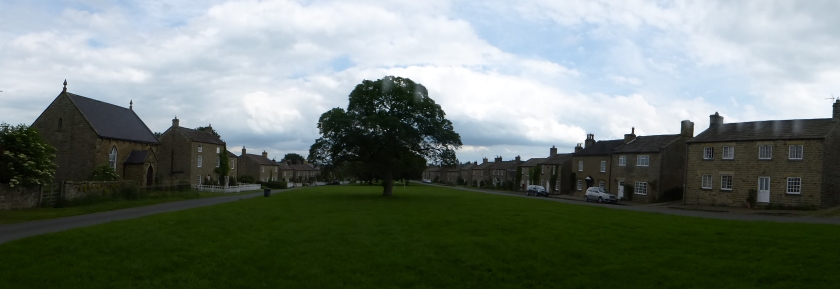This was a fine day for a walk, and a fine day to have a few history lessons thrown in
This is what we did. Here’s our starting point at East Witton, about 15 miles from home. It’s a lovely small village of about 250 people, where most of the houses were built in the early 19th century round the extensive village green.

We passed through fields with views across the Dales. We walked along a green lane, through woods, and eventually reached a wooded gorge through which the River Cover runs, and where we crossed over the charming stone bridge known as the Hullo Bridge. It was quite a climb up the hill on the other side, and we were hoping for glimpses of Braithwaite Hall. Too many trees in full leaf. We hardly glimpsed it.
It’s built on the site of a grange belonging to Jervaulx Abbey. After the Dissolution of the Monasteries it continued as a sheep farm, as it had been under the monks. This is an area where the monks of both Jervaulx and Fountains Abbey extended their influence widely: enormous numbers of sheepall over the region were managed from local granges where the lay brothers who cared for them lived.

We were nearly in Middleham now. This is above all a horsey town. The monks of Jervaulx bred horses, and brought them to the Moor to exercise them. When the monks eventually went, the horses remained, as did the training tradition . Middleham these days is home to around 15 racehorse trainers and 500 horses, yet it’s a small town of hardly more than 820 people. It was too late for us to see the horses out on the Gallops this morning, so instead the first thing we saw was the castle, which dates back to 1190 and was the stronghold of the powerful Neville family from the 14th century. Richard Plantagenet, later Richard III was sent here as a young man to be trained in arms by Richard Neville, Earl of Warwick, his cousin.

Warwick had the bad habit of changing sides throughout the Wars of the Roses (1455-1485) depending on whether the Yorkists or Lancastrians had the upper hand. Eventually he came to a bad end when he was killed by the Yorkist King Edward IV and his younger brother Richard. Edward gave Middleham Castle, and much else to Richard who lived there with his wife, virtually ruling the North of England, for 11 years. When Edward died, Richard seized the throne and reigned for only 2 years before dying in August 1485 in the final battle of the Wars of the Roses, the Battle of Bosworth in Leicestershire. And there his body remained for 517 years, before being exhumed from a car park in Leicester in 2012.
For us, Middleham was the site for a rather good picnic, followed by a visit to a teashop for an indifferent cup of tea, and even more indifferent cake. But the calories were useful. There were stiles to cross into fields deep in cut grass, waiting to dry off into hay: a fine walled track Straight Lane – to walk along before reaching the River Cover, languidly passing over bleached white stones on its way to meet the River Ure. We briefly touched the road once more as we passed Coverbridge Inn. This dates from 1684, and was owned by the same family – the Towlers – till 1930. Local legend has it that when the monks of Jervaulx were forced to disband in 1537 at the Dissolution of the Monasteries, they shared their secret recipe for Wensleydale cheese with the Towlers. We shall never know.
A final walk along woodland paths, open farmland, fields enclosed by characterful drystone walling and we were back in East Witton. A grand day.








I’m glad the weather held off for you, what a fine walk!
LikeLiked by 1 person
It was! And yes, perfect weather for a walk.
LikeLiked by 1 person
What a delightful way to spend the afternoon – walking, learning, and just being outdoors. How far did you walk?
LikeLiked by 1 person
Yes, it was fun. A simple 5 mile walk as Malcolm is still building up his walking strength after his recent op.
LikeLiked by 1 person
Ah Jervaulx – more from the fascinating Cistercians, they certainly understood the ‘economics’ of their age. And, it looks like you were gifted some beautiful weather for your walk.
LikeLiked by 1 person
It’s even better today.
LikeLiked by 1 person
Lovely! We do a similar walk but the other way round, so we tend to see the racehorses up on the Gallops. Mind you, it can be very wild up there, even on a summer’s day. Great to hear Malcolm is out and about too.We are doing a Lincolnshire Wold walk today – completely new area for us.
LikeLiked by 1 person
I’ll be interested to see how that goes. Very flat, Lincolnshire, non? I hope you had a postal vote, by the way!
LikeLike
Definitely not flat! Similar to the Yorkshire Wolds – dry valleys and rolling countryside. Rather lovely if only it would stop raining!
LikeLiked by 1 person
Rain, rain, go to Spain……
LikeLike
And yes – postal vote went a couple of weeks back! X
LikeLiked by 1 person
Phew……
LikeLike
A lovely ramble.
LikeLiked by 1 person
It was. Perfect weather too.
LikeLiked by 1 person
I want to come and hang out with you, and go on this walk! It looks like the perfect day, with the castle ruins and stiles and green places . . . and snacks! Have you read The Daughter of Time, by Josephine Tey? That’s where I got pretty much all my knowledge of Richard III.
LikeLiked by 1 person
No I haven’t! Thanks for the hint. Richard’s being given a much better press these days. People must have felt sorry for him, ending up in a car park 😉
LikeLike
The book is considered a classic in the mystery genre–really very interesting and well written!
LikeLiked by 1 person
Sounds like my kind of book. Thanks!
LikeLike
Great walk and history lesson! What I would only see as lovely countryside you bring alive with your stories. Sorry about the indifferent tea and cake but I enjoyed that turn of phrase😊.
LikeLike
Thanks! English tea shops usually do better.
LikeLike
We went to Middleham castle and loved it. Thanks for the memories.
LikeLiked by 1 person
Always worth a visit! Thanks.
LikeLike
A great gallery of photos to go with an interesting post. Sounds like a fun walk with lots to see. Extremely heavy rain overnight, this morning and again this evening so no nice walks for us!
LikeLiked by 1 person
Ah well, for once the north has scored. Wonderful weather here.
LikeLiked by 1 person
Nice today.
LikeLiked by 1 person
Good!
LikeLiked by 1 person